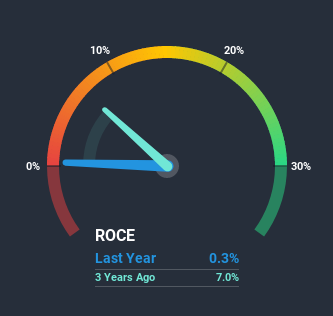- United States
- /
- IT
- /
- NasdaqCM:TSRI
Should We Be Excited About The Trends Of Returns At TSR (NASDAQ:TSRI)?
Finding a business that has the potential to grow substantially is not easy, but it is possible if we look at a few key financial metrics. Typically, we'll want to notice a trend of growing return on capital employed (ROCE) and alongside that, an expanding base of capital employed. Basically this means that a company has profitable initiatives that it can continue to reinvest in, which is a trait of a compounding machine. Having said that, from a first glance at TSR (NASDAQ:TSRI) we aren't jumping out of our chairs at how returns are trending, but let's have a deeper look.
Understanding Return On Capital Employed (ROCE)
Just to clarify if you're unsure, ROCE is a metric for evaluating how much pre-tax income (in percentage terms) a company earns on the capital invested in its business. Analysts use this formula to calculate it for TSR:
Return on Capital Employed = Earnings Before Interest and Tax (EBIT) ÷ (Total Assets - Current Liabilities)
0.0031 = US$41k ÷ (US$19m - US$6.3m) (Based on the trailing twelve months to August 2020).
Therefore, TSR has an ROCE of 0.3%. Ultimately, that's a low return and it under-performs the IT industry average of 9.6%.
See our latest analysis for TSR

Historical performance is a great place to start when researching a stock so above you can see the gauge for TSR's ROCE against it's prior returns. If you're interested in investigating TSR's past further, check out this free graph of past earnings, revenue and cash flow.
So How Is TSR's ROCE Trending?
When we looked at the ROCE trend at TSR, we didn't gain much confidence. To be more specific, ROCE has fallen from 7.0% over the last five years. Meanwhile, the business is utilizing more capital but this hasn't moved the needle much in terms of sales in the past 12 months, so this could reflect longer term investments. It's worth keeping an eye on the company's earnings from here on to see if these investments do end up contributing to the bottom line.
In Conclusion...
To conclude, we've found that TSR is reinvesting in the business, but returns have been falling. Since the stock has gained an impressive 98% over the last five years, investors must think there's better things to come. But if the trajectory of these underlying trends continue, we think the likelihood of it being a multi-bagger from here isn't high.
One final note, you should learn about the 3 warning signs we've spotted with TSR (including 1 which is significant) .
While TSR may not currently earn the highest returns, we've compiled a list of companies that currently earn more than 25% return on equity. Check out this free list here.
If you’re looking to trade TSR, open an account with the lowest-cost* platform trusted by professionals, Interactive Brokers. Their clients from over 200 countries and territories trade stocks, options, futures, forex, bonds and funds worldwide from a single integrated account. Promoted
Valuation is complex, but we're here to simplify it.
Discover if TSR might be undervalued or overvalued with our detailed analysis, featuring fair value estimates, potential risks, dividends, insider trades, and its financial condition.
Access Free AnalysisThis article by Simply Wall St is general in nature. It does not constitute a recommendation to buy or sell any stock, and does not take account of your objectives, or your financial situation. We aim to bring you long-term focused analysis driven by fundamental data. Note that our analysis may not factor in the latest price-sensitive company announcements or qualitative material. Simply Wall St has no position in any stocks mentioned.
*Interactive Brokers Rated Lowest Cost Broker by StockBrokers.com Annual Online Review 2020
Have feedback on this article? Concerned about the content? Get in touch with us directly. Alternatively, email editorial-team (at) simplywallst.com.
About NasdaqCM:TSRI
Flawless balance sheet with proven track record.
Market Insights
Community Narratives




